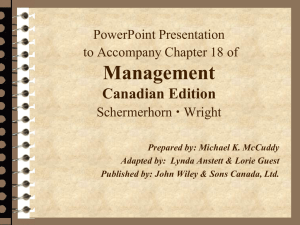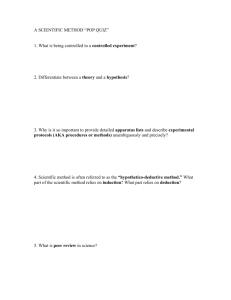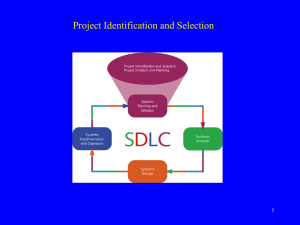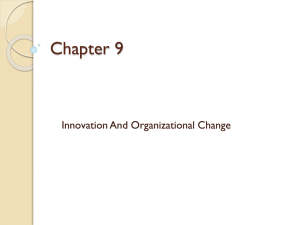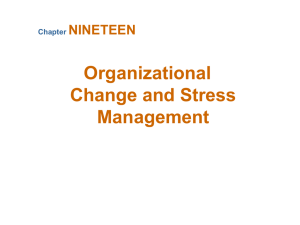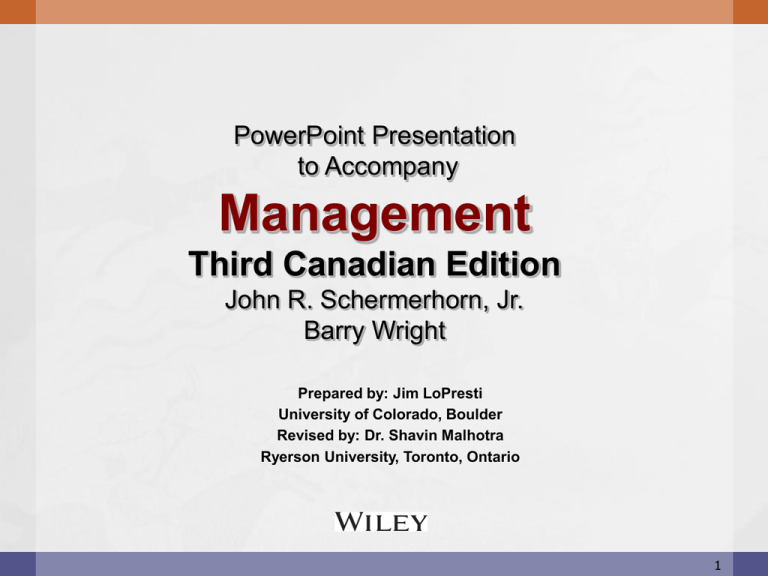
PowerPoint Presentation
to Accompany
Management
Third Canadian Edition
John R. Schermerhorn, Jr.
Barry Wright
Prepared by: Jim LoPresti
University of Colorado, Boulder
Revised by: Dr. Shavin Malhotra
Ryerson University, Toronto, Ontario
1
Chapter 9:
Innovation and Organizational Change
Management 3e – Chapter 9
2
Chapter 9 Learning Objectives
• 9.1 Understand how organizations
accomplish innovation.
• 9.2 Describe the nature of organizational
change.
• 9.3 Explain how to manage planned
organizational change.
• 9.4 Explain what is organization
development.
Management 3e – Chapter 9
3
Innovation and Organizations
Strategic leadership creates the capacity for
ongoing strategic change.
Components of strategic leadership:
• Anticipate, envision, maintain flexibility.
• Think strategically.
• Work with others to initiate change.
Management 3e – Chapter 9
4
Innovation and Organizations
Sustainable competitive advantage relies on
creativity and innovation.
Creativity is the generation of a novel idea or
unique approach to solving problems or
crafting opportunities.
Innovation is the process of creating new ideas
and putting them into practice.
Management 3e – Chapter 9
5
Innovation and Organizations
Three forms of innovation:
• Product.
• Results in the creation of new or improved
goods and services.
• Process.
• Results in better ways of doing things.
• Business model innovation.
• Results in new ways of making money.
Management 3e – Chapter 9
6
Innovation and Organizations
Sustainable innovation
• Creation of new products and processes that
have lower environmental impacts than the
available alternatives.
Green innovation
• The process of turning ideas into innovations
that reduce the carbon footprint of an
organization or its products.
Management 3e – Chapter 9
7
Innovation and Organizations
Social Business Innovation
• Using micro-credit lending to help create small
enterprises and fight poverty.
Social Entrepreneurship
• Pursues creative and innovative ways to solve
pressing social problems.
Management 3e – Chapter 9
8
Innovation and Organizations
Five steps of the innovation process:
•
•
•
•
•
Imagining
Designing
Experimenting
Assessing
Scaling
Commercializing innovation
• Process of turning new ideas into products or
processes that increase profits through sales or
cost reductions.
Management 3e – Chapter 9
9
Innovation and Organizations
Four steps of the product innovation
process:
• Idea creation
• Initial experimentation
• Feasibility determination
• Final application
Management 3e – Chapter 9
10
Figure 9.4 Process of commercializing innovation in
organizations: the case of new product development.
Management 3e - Chapter 9
11
Innovation and Organizations
Disruptive innovation
• Harvard scholar Clay Christensen defines it as
‘the creation of an innovative product or service
that starts out small scale and then moves up
market to where it becomes so widely used that
it displaces prior practices and competitors.’
• Examples include cellular phones and discount
retailers
Management 3e – Chapter 9
12
Innovation and Organizations
In highly innovative organizations …
• Corporate strategy and culture should:
• Emphasize an entrepreneurial spirit
• Expect innovation
• Accept failure.
• Be willing to take risks
• Organization structure should:
• Be organic
• Have lateral communications
• Use cross-functional teams and task forces
Management 3e – Chapter 9
13
Innovation and Organizations
In highly innovative organizations …
• Top management should:
• Understand the innovation process.
• Be tolerant of criticism and differences of opinion.
• Take all possible steps to keep goals clear.
• Maintain the pressure to succeed.
• Break down barriers to innovation.
• Staffing should fulfill five critical innovation roles:
• Idea generators.
• Information gatekeepers.
• Product champions.
• Project managers.
• Innovation leaders.
Management 3e – Chapter 9
14
Organizational Change
Change leader
• A change agent who takes leadership responsibility
for changing the existing pattern of behaviour of
another person or social system.
Change leadership
• Forward-looking.
• Proactive.
• Embraces new ideas.
Management 3e – Chapter 9
15
Figure 9.8 Change leaders versus status quo managers.
Management 3e - Chapter 9
16
Organizational Change
Top-down change
• Strategic and comprehensive change that is
initiated with the goals of comprehensive impact
on the organization and its performance
capabilities.
• Driven by the organization’s top leadership.
• Success depends on support of middle-level and
lower-level workers.
Management 3e – Chapter 9
17
Organizational Change
Bottom-up change
• The initiatives for change come from any and all
parts of the organization, not just top
management.
• Crucial for organizational innovation.
• Made possible by:
• Employee empowerment.
• Employee involvement.
• Employee participation.
Management 3e – Chapter 9
18
Organizational Change
Integrated change leadership
• Successful and enduring change combines
advantages of top-down and bottom-up
approaches.
• Top-down:
• Breaks up traditional patterns.
• Implements difficult economic adjustments.
• Bottom-up:
• Builds capability for sustainable change.
• Builds capability for organizational learning.
Management 3e – Chapter 9
19
Organizational Change
Transformational and incremental change
• Unplanned change
• Response to unanticipated events.
• Good leaders act on opportunities for reactive
change.
• Planned change
• Aligning the organization with anticipated future
•
•
•
challenges.
Activated by proactive leaders who are sensitive
to performance gaps.
Transformational change major and
comprehensive redirection.
Incremental change adjusting existing systems
and practices.
Management 3e – Chapter 9
20
Organizational Change
How to lead transformational change:
•
•
•
•
•
Establish a sense of urgency for change.
Form a powerful coalition to lead the change.
Create and communicate a change vision.
Empower others to move change forward.
Celebrate short-term “wins” and recognize those
who help.
• Build on success; align people and systems with
new ways.
• Stay with it; keep the message consistent;
champion the vision.
Management 3e – Chapter 9
21
Organizational Change
External forces for change:
•
•
•
•
•
•
•
Globalization.
Market competition.
Local economic conditions.
Government laws and regulations.
Technological developments.
Market trends.
Social forces and values.
Internal forces for change:
• Arise when change in one part of the system creates the
need for change in another part of the system.
• May be in response to one or more external forces.
Management 3e – Chapter 9
22
Organizational Change
Organizational targets for change:
• Tasks
• People
• Culture
• Technology
• Structure
Management 3e - Chapter 9
23
Managing Planned Change
Phases of planned change
• Unfreezing
• The phase in which a situation is prepared for
change and felt needs for change are developed.
• Changing
• The phase in which something new takes place
in the system, and change is actually
implemented.
• Refreezing
• The phase of stabilizing the change and creating
the conditions for its long-term continuity.
Management 3e - Chapter 9
24
Figure 9.11 Lewin’s three phases of planned
organizational change.
Management 3e - Chapter 9
25
Managing Planned Change
Force-coercion strategy of change
• Uses power bases of legitimacy, rewards and
punishments to induce change.
• Relies on belief that people are motivated by
self-interest.
• Direct forcing and political maneuvering.
• Produces limited and temporary results.
• Most useful in the unfreezing phase.
Management 3e - Chapter 9
26
26
Managing Planned Change
Rational persuasion strategy of change.
• Bringing about change through persuasion backed
by special knowledge, empirical data, and rational
argument.
• Relies on expert power.
• Relies on belief that reason guides people’s
decisions and actions.
• Useful in the unfreezing and refreezing phases.
• Produces longer-lasting and internalized change.
Management 3e – Chapter 9
27
Managing Planned Change
Shared power strategy of change
• Engages people in a collaborative process of identifying
•
•
•
•
values, assumptions, and goals from which support for
change will naturally emerge.
Time consuming but likely to yield high commitment.
Involves others in examining sociocultural factors
related to the issue at hand.
Relies on referent power and strong interpersonal
skills in team situations.
Relies on belief that people respond to sociocultural
norms and expectations of others.
Management 3e – Chapter 9
28
Figure 9.12 Alternative change strategies and their leadership
implications.
Management 3e – Chapter 9
29
Managing Planned Change
Reasons for people resisting change:
•
•
•
•
•
•
•
•
Fear of the unknown
Disrupted habits
Loss of confidence
Loss of control
Poor timing
Work overload
Loss of face
Lack of purpose
Management 3e – Chapter 9
30
Managing Planned Change
Checklist for dealing with resistance to change:
• Check the benefits – those involved see a clear
advantage
• Check the compatibility – keep change similar to
existing values/processes
• Check the simplicity – make it as easy as possible
to understand
• Check the triability – allow people to slowly try
the change adjusting as progression is made
Management 3e – Chapter 9
31
Organization Development
Organization development (OD): a
comprehensive approach to planned
organizational change that involves the
application of behavioural science in a
systematic and long-range effort to improve
organizational effectiveness.
Management 3e – Chapter 9
32
Organization Development
Organization development goals:
• Outcome goals focus on task accomplishments.
• Process goals focus on the way people work
together.
• OD seeks to develop the organization members’
capacity for self-renewal.
• OD is committed to change through freedom of
choice, shared power, and self-reliance.
• OD takes advantage of knowledge about human
behaviour in organizations.
Management 3e - Chapter 9
33
Organization Development
The organization development process:
• Establish a working relationship
• Diagnosis
• Intervention
• Evaluation
• Achieve a terminal relationship
Management 3e – Chapter 9
34
Figure 9.14 Organization development and the planned
change process.
Management 3e - Chapter 9
35
Organization Development
Action research
• The process of systematically collecting data on an
organization, feeding it back to the members for
action planning, and evaluating results by
collecting more data and repeating the process as
necessary.
• Is initiated when someone senses a performance
gap.
Management 3e – Chapter 9
36
Organization Development
Steps in the action research process:
•
•
•
•
•
Data gathering.
Data analysis and feedback.
Action planning.
Action implementation.
Evaluation and follow-up.
Management 3e – Chapter 9
37
Organization Development
Individual OD interventions
•
•
•
•
•
Sensitivity training (T-groups)
Management training
Role negotiation
Job redesign
Career planning
Team OD interventions
• Team building
• Process consultation
• Inter-group team building
Organization-wide OD interventions
• Survey feedback
• Confrontation meeting
• Structural redesign
• Management by objectives (MBO)
Management 3e – Chapter 9
38
COPYRIGHT
Copyright © 2014 John Wiley & Sons Canada, Ltd. All
rights reserved. Reproduction or translation of this work
beyond that permitted by Access Copyright (The
Canadian Copyright Licensing Agency) is unlawful.
Requests for further information should be addressed to
the Permissions Department, John Wiley & Sons Canada,
Ltd. The purchaser may make back-up copies for his or
her own use only and not for distribution or resale. The
author and the publisher assume no responsibility for
errors, omissions, or damages caused by the use of these
programs or from the use of the information contained
herein.
39

